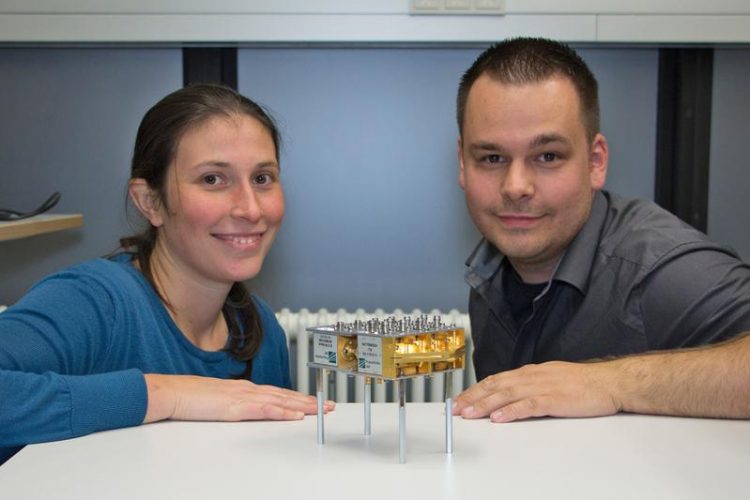Ultra-high data rates transmitted at THz frequencies

Iulia Dan (Universität Stuttgart) and Sebastian Rey (Technische Universität Braunschweig) with the TERAPAN module for electronic beam steering. TU Braunschweig/Sebastian Rey
How will we cooperate in the future office? It is for granted, that ever increasing data volumes have to be made available within ultra-short time periods. This sets high-level requirements on the wireless communication infrastructure.
The use THz frequencies form 300 GHz to 3 THz enable the transmission of Terabytes of data within a couple of seconds. Before this spectrum can be commercially explored high technological hurdles have to be overcome. One challenges could be now met: For the first time electronic beam steering at such high frequencies has been demonstrate replacing mechanical beam steering, which was used up to now.
This is a major step towards an industrial the realization in applications like wireless data centers, smart office or wireless backhauling in cellular networks.
Researchers from Technische Universität Braunschweig, the Universität Stuttgart and Fraunhofer Institut für angewandte Festkörperphysik at Freiburg IAF demosonstrate electronic beamsteering at the NGMN Industry Conference and Exhibition taking place at Frankfurt on 12-13 October 2016.
This will complement the demonstration of multi-gigabit data transmission at a carrier frequency of 300 GHz shown for the first time by the same TERAPAN consortium (Terahertz Communication for future Personal Area Networks) in March 2015.
„We have reached a mile stone n the way to the development of commercial applications for wireless communications at THz frequencies”, explains Prof. Thomas Kürner, project coordinator of the TERAPAN. “EBy electronic beam steering we are able to significantly improves the demonstrator compared to its first version towards practical applications of the concept.”
TERAPAN is funded by the German Federal Ministry of Education and Research under the framework of its VIP (validating the innovation potential) initiative and runs from August 2013 to July 2016. The Project partners complement their expertise in design and fabrication of monolithically integrated transceiver chips including their characterization with the design of wireless systems at terahertz frequencies.
Contact details:
Prof. Dr.-Ing. Thomas Kürner
Institut für Nachrichtentechnik
Technische Universität Braunschweig
Schleinitzstraße 22
38106 Braunschweig
Tel.: 49 531 391-2416
E-Mail: kuerner@ifn.ing.tu-bs.de
Media Contact
All latest news from the category: Power and Electrical Engineering
This topic covers issues related to energy generation, conversion, transportation and consumption and how the industry is addressing the challenge of energy efficiency in general.
innovations-report provides in-depth and informative reports and articles on subjects ranging from wind energy, fuel cell technology, solar energy, geothermal energy, petroleum, gas, nuclear engineering, alternative energy and energy efficiency to fusion, hydrogen and superconductor technologies.
Newest articles

Superradiant atoms could push the boundaries of how precisely time can be measured
Superradiant atoms can help us measure time more precisely than ever. In a new study, researchers from the University of Copenhagen present a new method for measuring the time interval,…

Ion thermoelectric conversion devices for near room temperature
The electrode sheet of the thermoelectric device consists of ionic hydrogel, which is sandwiched between the electrodes to form, and the Prussian blue on the electrode undergoes a redox reaction…

Zap Energy achieves 37-million-degree temperatures in a compact device
New publication reports record electron temperatures for a small-scale, sheared-flow-stabilized Z-pinch fusion device. In the nine decades since humans first produced fusion reactions, only a few fusion technologies have demonstrated…





















